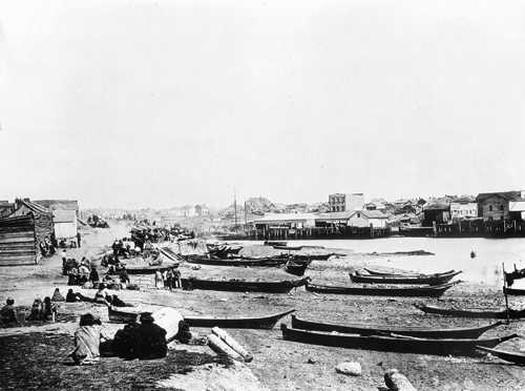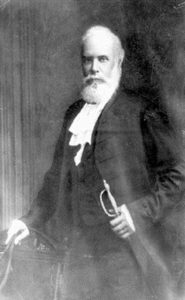Amelia Copperman
Values (you decide)
Amelia and William Copperman, Prussian immigrants, were married in 1852, in San Francisco.
They departed in 1858 on board the S.S. Commodore bound for Victoria. t was an ill-fated voyage.
The damaged ship listed back to port, and the Coppermans had lost all of their belongings and trading inventory.
Later that same year, Amelia and William Copperman arrived in Victoria to find it crowded with miners, but no accommodations.
They set up a tent and a makeshift booth from which they could sell and barter their wares.
The Coppermans were the first known licensed Jewish “Indian Traders” in Victoria.
Their “Indian Trading Post” and residence was a hastily built shack on Store Street.
The Coppermans had good relations with their First Nations customers and employees, worked hard, and prospered.
They built a one-story structure, fronting on Store Street at the foot of Cormorant in 1861.
They owned several newly built houses on Fisguard, between Store and Government Streets .
Their tenants were usually Indians.
In 1862, William Copperman became a naturalized citizen. Amelia, as his wife, shared in this status.
In 1863, William and Amelia travelled to San Francisco in the Spring, returning on the S.S. Sierra Nevada to Victoria.
According to Victoria newspaper accounts, Amelia and William Copperman were vulnerable to break-ins and burglaries, various conflicts, altercations, arrests and court cases.
Independent Woman of Means
Amelia and William were childless after ten years of marriage and William received a get (Jewish certificate of divorce).
During a court case, Mr. Malowanski testified that the couple had been divorced according to the ritual of the Hebrew faith in the presence of a Rabbi and Messrs. Sutro, Reinhart and Gambitz, and the sum of $5,000 was paid to Mrs. Copperman in consideration of the divorce.
After their acrimonious divorce, William Copperman returned to Germany.
Amelia Copperman remained to carry on the Store Street business by herself.
The trading post and its attached residence were solely hers.
Now she was more vulnerable to thievery and break-ins:
In 1864, two armed men, in search of her reputed riches, burst in to Amelia’s living quarters while she was asleep.
The watchman she had hired, who usually stopped by three times a night, interrupted the caper but was viciously beaten about the head with their pistols.
A young policeman heard the commotion and blew his whistle. He scuffled with the robbers as they rushed past him.
In the dim light, the watchman, blinded by the blood flowing from his wounds, fired his revolver towards the escaping thugs, but shot the policeman through the heart.
In 1866, Amelia reported three incidents of thievery and incarceration followed.
In 1867, when Amelia was absent, burglars forced entry and made off with a substantial fortune.
An iron bar was found nearby, which had been used to force open the locked wardrobe.
Amelia advertised a $300 reward. This caused a sensation.
There were rumors of the missing treasure being buried. Hundreds of people set out on the hunt.
No thief was detected; the burglary had been “boldly planned and executed.”
Hard Times
In 1867, commerce was at its lowest ebb.
Merchants and traders left for the Alaska Territory.
Amelia was still struggling in her trading post.
Amelia confronted a Native customer, who was so enraged that he knocked her down and viciously kicked her in the chest.
By 1870, Amelia, no longer a trader, was living in a rented house, and had her belongings seized as forfeit in lieu of non-payment of rent.
Two Jewish businessmen advised and urged her to pursue the confiscated belongings.
When Amelia presented paid rental receipts, she was accused of forgery.
Unable to raise enough money for bail, she was taken into custody.
Amelia “skipped town — absconded,” and “… she crossed the Sound to Olympia ….”
“Mrs. Copperman has proved herself so great an adept at forging that she ought to go into the blacksmith business.”
— A Colonist reporter
The Alaska Times, a Seattle newspaper, informed readers that Amelia Copperman was sighted in Olympia, Washington Territory.
It was rumored that she had been abducted by the two businessmen, which was publicly denied.
In 1871, Amelia returned from Puget Sound on the S.S. Isabel to face down the cynics and her accusers.
She was taken into custody and “lodged in gaol.”
In Police Court, Amelia was on remand for two charges, committing forgery, and willful and corrupt perjury
Desperate for money, she went after one of the advising businessmen to collect the $1,700 that he owed her.
He “cut and ran” across the border to Olympia.
Amelia tried suing him in court, but was unsuccessful in recovering the money.
The other advisor had also taken advantage of business arrangements.
A solitary figure at her trial, Amelia had not hired a defense lawyer.
The gallant gentleman stepped forward and said, “in the absence of better, your Lordship, I’ll watch the case; she is deaf.”
He was the lawyer who had served as the prosecutor against William Copperman during the divorce scandal, and as her defense lawyer in other cases.
Twelve gentlemen were sworn in on the “petty jury,” with Judge Pemberton presiding.
Amelia was deaf, and a German speaking interpreter was called for — but not found.
The Attorney General could not produce any incriminating evidence.
The Judge advised the jury to find Amelia not guilty.
“His Lordship believed the prisoner to be a scandalous, perjured old woman; one utterly untrustworthy; but she could not be legally convicted.”
In 1873, Amelia was arrested, again, and fined for selling beer, an “intoxicating liquor,” to Native women.
In 1874, Amelia was arrested for having intoxicated Indian women and a keg of beer in her residence at the top of Fort Street.
Amelia defended herself. She was found guilty, but being unable to pay the fine, was sentenced to six months in jail.
After being discharged from jail in 1876, Amelia left Victoria aboard the S.S. California bound for the port of Sitka on Baranov Island, Alaska.
There, Amelia attended a wedding at the Cathedral of Saint Michael, the old Russian church.
She was taken ill and died there, in Sitka.
There were no newspapers published in Sitka at that time and no civilian government to register births, marriages, or deaths.
Sources
- Cyril Leonoff, editor, “Pioneer Jews of British Columbia,” Western States Jewish History 37/3&4.
- Sarah H. Tobe, “Lured North of the 49th, Jewish Colonial Roots,” Western States Jewish History 46/2&3.
- Christopher J. P. Hanna, historical researcher, Sarah H. Tobe, author, “Tracking Amelia Copperman,” The Scribe, JHSBC, 7/2 (2002).
Sarah H. Tobe is curator of this Amelia Copperman exhibit.

